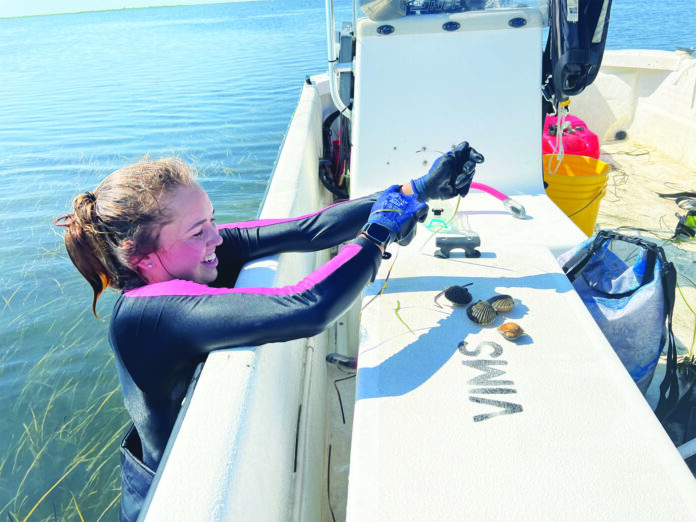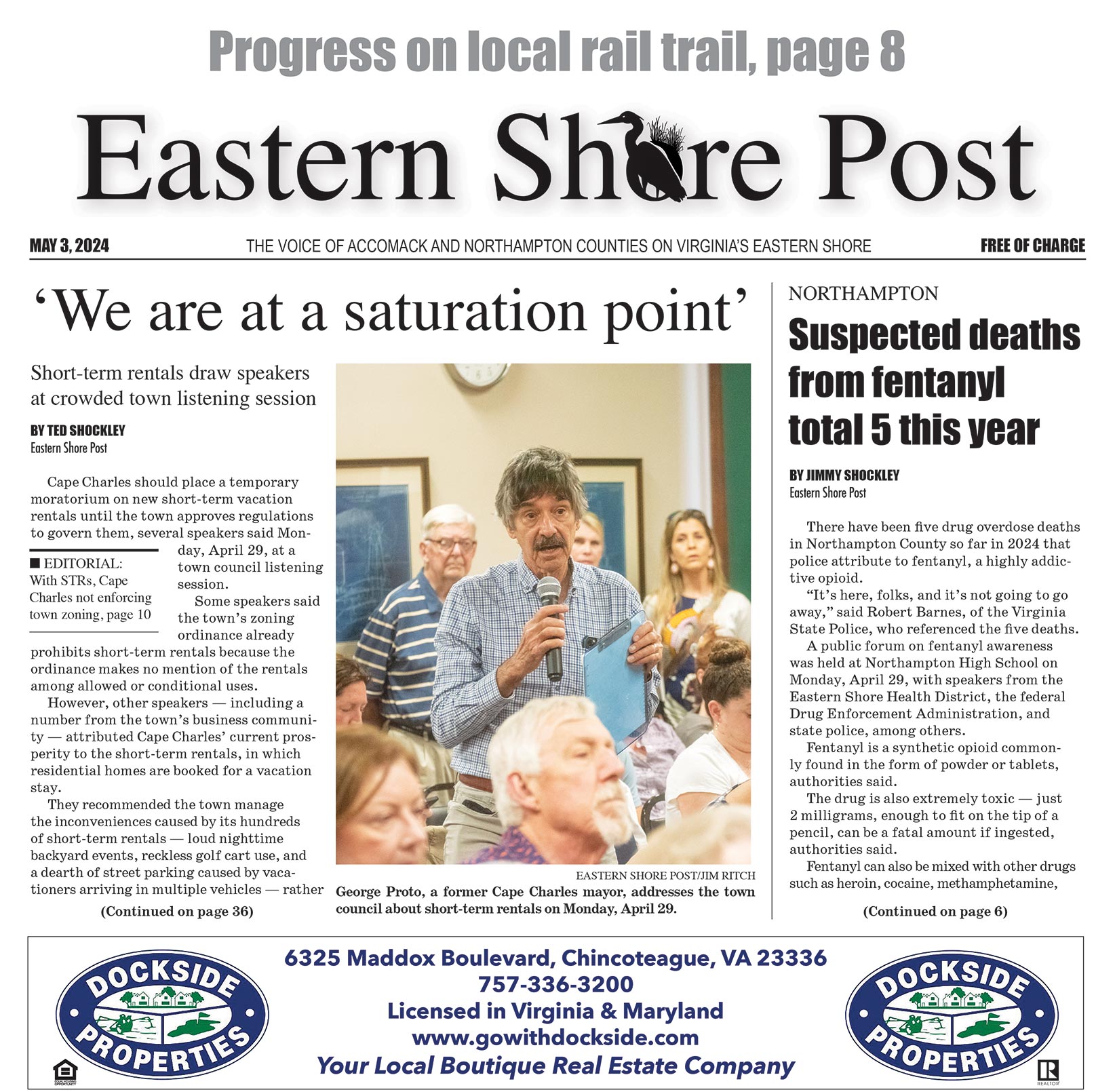
BY STEFANIE JACKSON, Eastern Shore Post
Virginia’s bay scallop population fell into steep decline after its seagrass habitat was decimated by a deadly combination of disease and a 1933 hurricane.
Today, however, Eastern Shore conservation partners are rebuilding a sustainable scallop population to support future recreational and commercial harvests.
The Virginia Institute of Marine Science began its annual scallop survey on Tuesday, July 11, and by the end of the first of a three-day job, the data looked promising, said Richard Snyder, director of the VIMS Eastern Shore Lab in Wachapreague.
A self-sustaining population of bay scallops would add another popular product to the Eastern Shore’s seafood industry.
Snyder said more than half of Virginia’s seafood landings in 2021 came from Accomack and Northampton counties, including the state’s harvest of hard clams, which was worth $58 million.
Bay scallops have the potential to join the ranks of Virginia’s and the Eastern Shore’s top shellfish, after hard clams, oysters, and blue crabs.
But the environmental benefit would be bigger than just bay scallops.
With the help of restoration efforts, all of the natural elements that make up the Eastern Shore’s seaside — from the eelgrass and bay scallops to the intertidal oyster reefs and marshes — will combine to make an “incredibly productive” ecosystem, Snyder said.
“We’re restoring an entire habitat,” Snyder said.
One-third of the way
Boat crews left the Oyster dock early Tuesday morning and headed to South Bay to begin the survey.
Accompanying Snyder on one of the boats, the Coquina, were John Lewis, seawater lab manager for the VIMS Eastern Shore Lab, and interns Leslie Youtsey and Macy Richardson.
At low tide, each crew member went into the waters of South Bay with a tool called a quadrat, a one-square-meter frame of PVC pipe. The researchers placed them on the bay bottom and scoured the framed areas for scallops.
It’s a challenging exercise for the unexperienced. Since visibility is low on the murky bottom, the researchers must wear weighted belts over their wetsuits so they can sink down on their knees and sweep their hands over the framed areas, typically thick with seagrass, to search for scallops.
The first day of the survey presented yet another challenge. The participants usually snorkel along the bottom to search for scallops, but this was not possible at many of the sites the crew visited, where the water was one meter deep or more.
The researchers had to hold their breath, drop to the bottom, and work quickly to find scallops.
Most participants checked an average of 10 square meters per site. Sometimes they came up empty-handed and other times they found several scallops.
The target is to find at least one scallop in every 10 square meters of bay bottom, which is sufficient to demonstrate that the scallop population is self-sustaining and recreational or commercial harvest is permissible.
Florida, one of the only states to permit recreational scallop harvesting, established the required ratio of one scallop per 10 square meters, which VIMS adopted.
As of last year, the bay scallop population was about one-third of the way to the target, Snyder said.
When the bay scallop population is sustainable to support recreational or commercial harvesting, the Virginia Marine Resources Commission will be responsible to set the appropriate regulations.
Building on successes
The Eastern Shore scallop survey has been an annual event for about the last decade, but the story of the bay scallop restoration project begins around 30 years ago.
Since the Chesapeake-Potomac hurricane of 1933 wiped out the eelgrass on the Eastern Shore’s seaside, home to Virginia’s barrier islands, the habitat has struggled to recover.
But in the 1990s, VIMS professor Robert Orth discovered a method of growing eelgrass from seed, and it produced positive results in South Bay and beyond.
Every seeded acre produced 14 acres of seagrass meadow, and the project became the most successful of its kind in the world, Snyder said.
There are now more than 9,000 acres of eelgrass in the project area, and it continues to grow and expand.
Another VIMS professor, Mark Luckenbach, began the restoration of the bay scallop population with scallops from North Carolina.
Luckenbach relied on the methods developed by VIMS researcher Mike Castagna in the 1960s and published in the early 1970s. The VIMS shellfish hatchery is named for Castagna.
Snyder took over for Luckenbach in 2015 and built on his peer’s initial success.
He was concerned about the scallops’ genetic diversity and brought in new scallops from North Carolina, Florida, and New York.
With the biodiversity created by four different populations of bay scallops, their numbers have been climbing every year, Snyder said.
Scallops in the lab
All of the scallops found during the survey are taken to the VIMS Eastern Shore Lab so researchers like intern Leslie Youtsey can extract DNA samples to analyze and determine what characteristics the genetic diversity has given to the bay scallops. The scallops are then returned to their habitats.
Youtsey works under the guidance of Jan McDowell, manager of the VIMS fisheries and genetics lab.
Another intern, Macy Richardson, works alongside research hatchery manager Reba Smith to help the scallops repopulate the waters surrounding Virginia’s barrier islands.
Smith facilitates the spawning process in the hatchery, with the female scallops producing eggs that are fertilized by the male scallops. The fertilized eggs then grow into larvae.
VIMS also maintains spawning cages, from which scallops spawn directly into the water.
Darian Kelley is the manager of the VIMS nursery, which protects the scallops as they grow into juveniles with the distinctively shaped shells that are recognized all around the world.
Many partners
Restoring the bay scallops’ habitat is a massive project that requires many partners.
Snyder works with Christopher Patrick, VIMS director of seagrass monitoring and restoration, who took over for Orth, the eelgrass-growing pioneer.
Another of their partners is Bo Lusk, a coastal scientist for The Nature Conservancy’s Volgenau Virginia Coast Reserve, headquartered at the Brownsville Preserve in Nassawadox.
The reserve spans 14 barrier islands and includes areas of the bay scallop and eelgrass restoration projects.
Lusk works with Patrick and assists with the eelgrass restoration, distributing seeds and monitoring growth.
Sean Fate, watercraft operations manager for the VIMS Eastern Shore Lab, coordinates the annual bay scallop survey with all of the participating entities.
The restoration work is costly but is supported by grant funding.
VIMS announced in February that it was awarded $1.5 million in aquaculture grants from the National Oceanic and Atmospheric Administration, or NOAA, for the 2023 grant cycle.
VIMS also announced in May the award of a $2.25 million NOAA grant to expand its scallop and seagrass restoration project into Burtons Bay, near Wachapreague.
That grant will allow VIMS to partner with TNC to plant 60 acres of eelgrass and release more than 6 million scallops into Burtons Bay.
Their work makes an impact on both the ecology and economy of Virginia’s Eastern Shore.
Eelgrass provides a protective habitat for bay scallops and also slows down waves, protecting the shores from erosion.
Bay scallops around Virginia’s barrier islands, like oysters in the Chesapeake Bay, consume algae and plankton, helping to keep the water clean and allowing more sunlight to reach marine plant life, like eelgrass.


